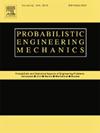A modified Fourier model for stochastic jumping loads on rigid floors
IF 3
3区 工程技术
Q2 ENGINEERING, MECHANICAL
引用次数: 0
Abstract
This paper introduces a modified Fourier model for accurately simulating the induced stochastic dynamic jumping force exerted by an individual during jumping motion on a rigid floor. The contact ratio, pace frequency, and amplification factor are the critical parameters in the force modeling. These parameters are considered as random variables. The mean, standard deviation, and interval of variation for the parameters have been computed based on experimental records of individual jumping force-time history. Correlation analysis indicates that the pace frequency and the contact ratio are weakly dependent variables. Moreover, analysis of experimental data shows that the amplification factor depends on both the contact ratio and pacing frequency. To account for this, the modified amplification factor has been incorporated into a truncated Fourier series to model the continuous rhythmic jumping force. The bootstrap resampling technique has been utilized to capture the inherent randomness in the jumping force. Additionally, successive corrections, in terms of the time difference between the metronome beat frequency and the achieved jumping frequency, have been applied in each load cycle to produce the jumping force. Comparisons between the measured force signals and the model-generated forces demonstrate strong agreement. Finally, the jumping vandal loading is simulated on a steel floor in a finite element model, and the responses for both, i.e., the model and the experimental forces, are compared. The results demonstrate that the proposed jumping force model is simple and can be easily used for the vibration serviceability assessment of structures.
求助全文
约1分钟内获得全文
求助全文
来源期刊

Probabilistic Engineering Mechanics
工程技术-工程:机械
CiteScore
3.80
自引率
15.40%
发文量
98
审稿时长
13.5 months
期刊介绍:
This journal provides a forum for scholarly work dealing primarily with probabilistic and statistical approaches to contemporary solid/structural and fluid mechanics problems encountered in diverse technical disciplines such as aerospace, civil, marine, mechanical, and nuclear engineering. The journal aims to maintain a healthy balance between general solution techniques and problem-specific results, encouraging a fruitful exchange of ideas among disparate engineering specialities.
 求助内容:
求助内容: 应助结果提醒方式:
应助结果提醒方式:


